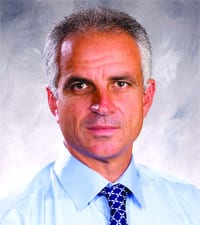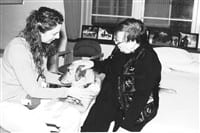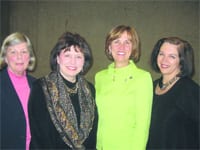Time for a Screening Osteoporosis Isn’t Simply a Matter for the Elderly
It’s not just about age, says Dr. Kamal Shoukri.
He was talking about osteoporosis, and when women should be screened for the bone-weakening disease. Specifically, the National Osteoporosis Foundation (NOF) recommends regular bone-density screenings for women age 65 and older, but age isn’t the only factor.
“Some will want to do that earlier,” said Shoukri, who directs the Endocrine Fellowship Program at Baystate Medical Center. “You can have a fracture earlier, even though the fracture rate rises after age 65.
“For the population at large, 65 is probably reasonable,” he continued, “but if a woman has already had a fragility fracture — not being hit by a truck, but falling from a standing position with minimal trauma and breaking a bone — she should probably have a screening to see where she stands.” Other risk factors, ranging from chronic diseases to medications to family history, also play a role.
The data can be dizzying, which is why women need to talk to their doctors about when they should be screened, because each case is different.
“Women do not perceive themselves to be personally at risk for osteoporosis, even though one in two women aged 50 and older will experience an osteoporosis-related fracture in their lifetime,” noted Judith Cranford, NOF executive director. “Women age 45 and older may be aware of osteoporosis, but do not relate that awareness to their own risk.”
Fragile, Handle with Care
Osteoporosis — literally ‘porous bone’ — is a disease characterized by low bone mass and structural deterioration of bone tissue, leading to bone fragility and increased susceptibility to fractures, especially of the hip, spine, and wrist, although any bone can be affected.
Fractures of the hip and spine are especially serious, particularly in the elderly. A hip fracture almost always requires hospitalization and major surgery, can impair a person’s ability to walk unassisted, and may cause prolonged or permanent disability or even death. Spinal or vertebral fractures also have serious consequences, including loss of height, severe back pain, and deformity.
Some 40 million Americans are afflicted with or at risk for osteoporosis, the vast majority of them women. Each passing year increases the risk, but other risk factors come into play as well, including being small and thin, a diet low in calcium, lack of adequate vitamin D, smoking, and drinking too much alcohol.
A bone densitometer, the device most commonly used to test bone density, uses X-rays to produce images of the spine, hip, or even the entire body. The X-ray is composed of two energy levels which are absorbed differently by the bones in the body, and a computer is able to determine from these differences how much bone mineral is present.
A patient’s physician can work through his or her risk factors to determine the need for screening. But in general terms, according to the NOF, the following people should be tested for bone density on a regular basis:
- Postmenopausal women under age 65, and men age 50 to 70, with one or more risk factors for osteoporosis;
- Women age 65 or older, or men age 70 or older, with or without risk factors;
- Women or men after age 50 who have broken a bone;
- Women going through menopause with certain risk factors; and
- Postmenopausal women who have stopped taking estrogen therapy or hormone therapy.
- In addition, certain other risk factors could warrant regular screenings, including:
- Long-term use of certain steroids (such as prednisone and cortisone) or anti-seizure medications;
- Having received treatments for prostate cancer or breast cancer;
- Overactive thyroid gland (hyperthyroidism) or taking high doses of thyroid hormone medication;
- Overactive parathyroid gland (hyperparathyroidism);
- X-ray of the spine showing a fracture or bone loss;
- Back pain with a possible fracture;
- Significant loss of height;
- Loss of sex hormones at an early age, including early menopause; or
- Having a disease or condition that can cause bone loss, such as rheumatoid arthritis or anorexia nervosa.
Despite the clear guidelines, the NOF argues that too many women look only at their age and not their other risk factors in determining whether to seek a bone-density test. Even though the majority of women age 45 and older have at least two risk factors for osteoporosis, the organization reports, only 15{06cf2b9696b159f874511d23dbc893eb1ac83014175ed30550cfff22781411e5} of those women not diagnosed by a doctor believe they are at risk for the disease.
“Women need to know their health risk for osteoporosis and what they can do to prevent the disease,” argued Josefina Carbonell, assistant secretary for Aging for the U.S. Department of Health and Human Services, which funded the NOF survey. “While we know that effective prevention, diagnosis, and treatment strategies exist for osteoporosis, many women have not taken action. We want to reverse this trend. We want women empowered on this issue, and we want them taking action to prevent this debilitating disease.”
Before It’s Too Late
Prevention is only part of the battle, of course. Fortunately for the millions who already suffer from osteoporosis, doctors have a range of treatments from which to choose.
“We certainly have a lot of therapies for osteoporosis,” said Shoukri. “There are estrogen-like substances that work like estrogen on the bone. There’s a whole group of medications called biphosphenates that interfere with the cells that break bones down. And there are parathyroid hormone injections that activate the cells that form bone.
“There are so many alternatives for treatment,” he continued. “The trick is knowing when to treat, how to treat, and how long to treat — in addition to providing lots of advice on health maintenance. For instance, it’s important to maintain a good intake of calcium and vitamin B, and weight-bearing exercises are important. All these pieces of advice are good for women at any age, but particularly after menopause, which is a time when they’re at the most risk of losing bone.”
Again, however, he stressed the importance of taking preventative steps long before treatment is necessary. It’s an ongoing struggle to convince women to be aware of the need, said Dr. Bess Dawson-Hughes, NOF president.
“We want to encourage women to assess their personal risk,” she said, “and take the preventative steps — including speaking to their health care professional — that can help them to protect their bones.”




Comments are closed.